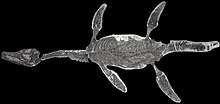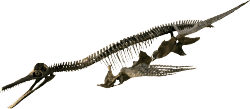Cryptoclidus
Cryptoclidus (/krɪptoʊˈklaɪdəs/ krip-toh-KLY-dəs) is a genus of plesiosaur reptile from the Middle Jurassic period of England, France, and Cuba.[1]
| Cryptoclidus | |
|---|---|
| Cast of a fossil skeleton, University of Tübingen | |
| Scientific classification | |
| Kingdom: | Animalia |
| Phylum: | Chordata |
| Class: | Reptilia |
| Superorder: | †Sauropterygia |
| Order: | †Plesiosauria |
| Family: | †Cryptoclididae |
| Subfamily: | †Cryptoclidinae |
| Genus: | †Cryptoclidus Seeley, 1892 |
| Type species | |
| †Cryptoclidus eurymerus | |
| Species | |
| |
| Synonyms | |
| |
Discovery
Cryptoclidus was a plesiosaur whose specimens include adult and juvenile skeletons, and remains which have been found in various degrees of preservation in England, Northern France, Russia, and South America. Its name, meaning "hidden clavicles", refer to its small, practically invisible clavicles buried in its front limb girdle.
The type species was initially described as Plesiosaurus eurymerus by Phillips (1871). The species name "wide femur" refers to the forelimb, which was mistaken for a hindlimb at the time.
Classification
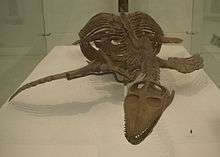
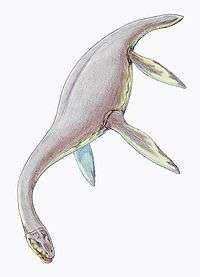
The cladogram below follows the topology from Benson et al. (2012) analysis.[2]
Paleobiology
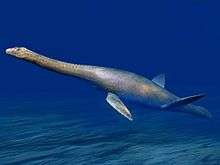
The fragile build of the head and teeth preclude any grappling with prey, and suggest a diet of small, soft-bodied animals such as squid and shoaling fish. Cryptoclidus may have used its long, intermeshing teeth to strain small prey from the water, or perhaps sift through sediment for buried animals.[3]
The size and shape of the nares and nasal openings have led Brown and Cruickshank (1994) to argue that they were used to sample seawater for smells and chemical traces.[4]
Distribution
Fossils of Cryptoclidus have been found in the Oxford Clay of Cambridgeshire, England. The dubious species Cryptoclidus beaugrandi is known from Kimmeridgian-age deposits in Boulogne-sur-Mer, France.[5] Cryptoclidus vignalensis hails from the Jagua Formation of western Cuba.
References
- Brown, David S., and Arthur RI Cruickshank. The skull of the Callovian plesiosaur Cryptoclidus eurymerus, and the sauropterygian cheek. Archived 2014-03-24 at the Wayback Machine Palaeontology 37.4 (1994): 941.
- Benson, R. B. J.; Evans, M.; Druckenmiller, P. S. (2012). Lalueza-Fox, Carles (ed.). "High Diversity, Low Disparity and Small Body Size in Plesiosaurs (Reptilia, Sauropterygia) from the Triassic–Jurassic Boundary". PLoS ONE. 7 (3): e31838. doi:10.1371/journal.pone.0031838. PMC 3306369. PMID 22438869.
- Palmer, D., ed. (1999). The Marshall Illustrated Encyclopedia of Dinosaurs and Prehistoric Animals. London: Marshall Editions. p. 75. ISBN 1-84028-152-9.
- Brown and Cruickshank, 1994
- Bologne-sur-Mer at Fossilworks.org
Further reading
- Z. Gasparini and L. Spaletti. 1993. First Callovian plesiosaurs from the Neuquen Basin, Argentina. Ameghiniana 30(3):245-254
